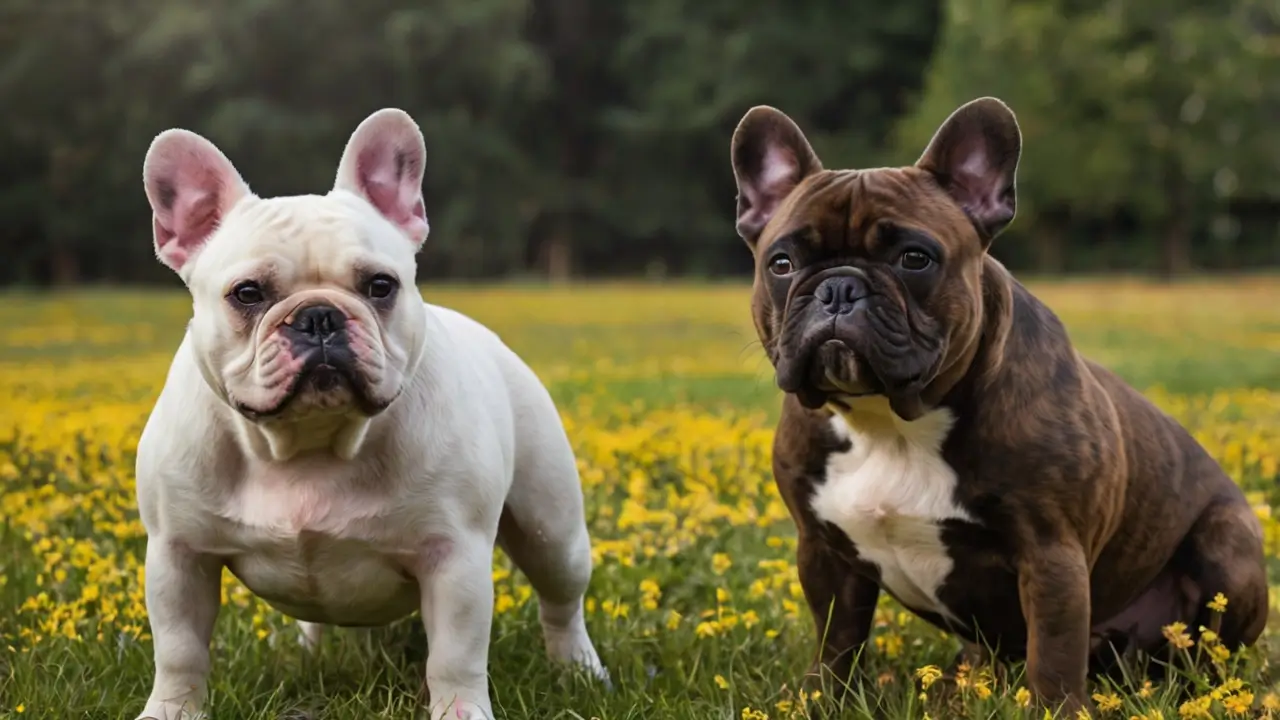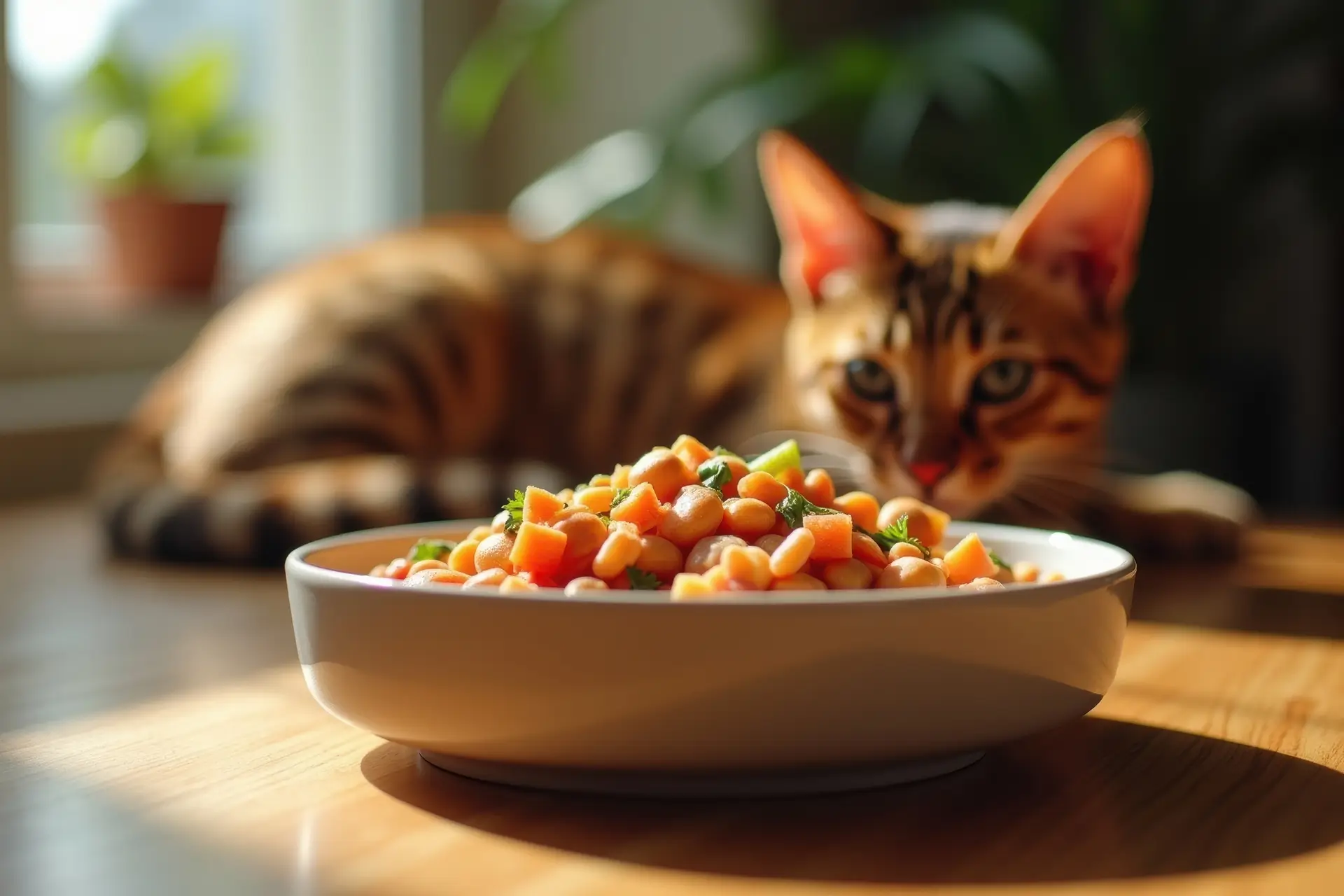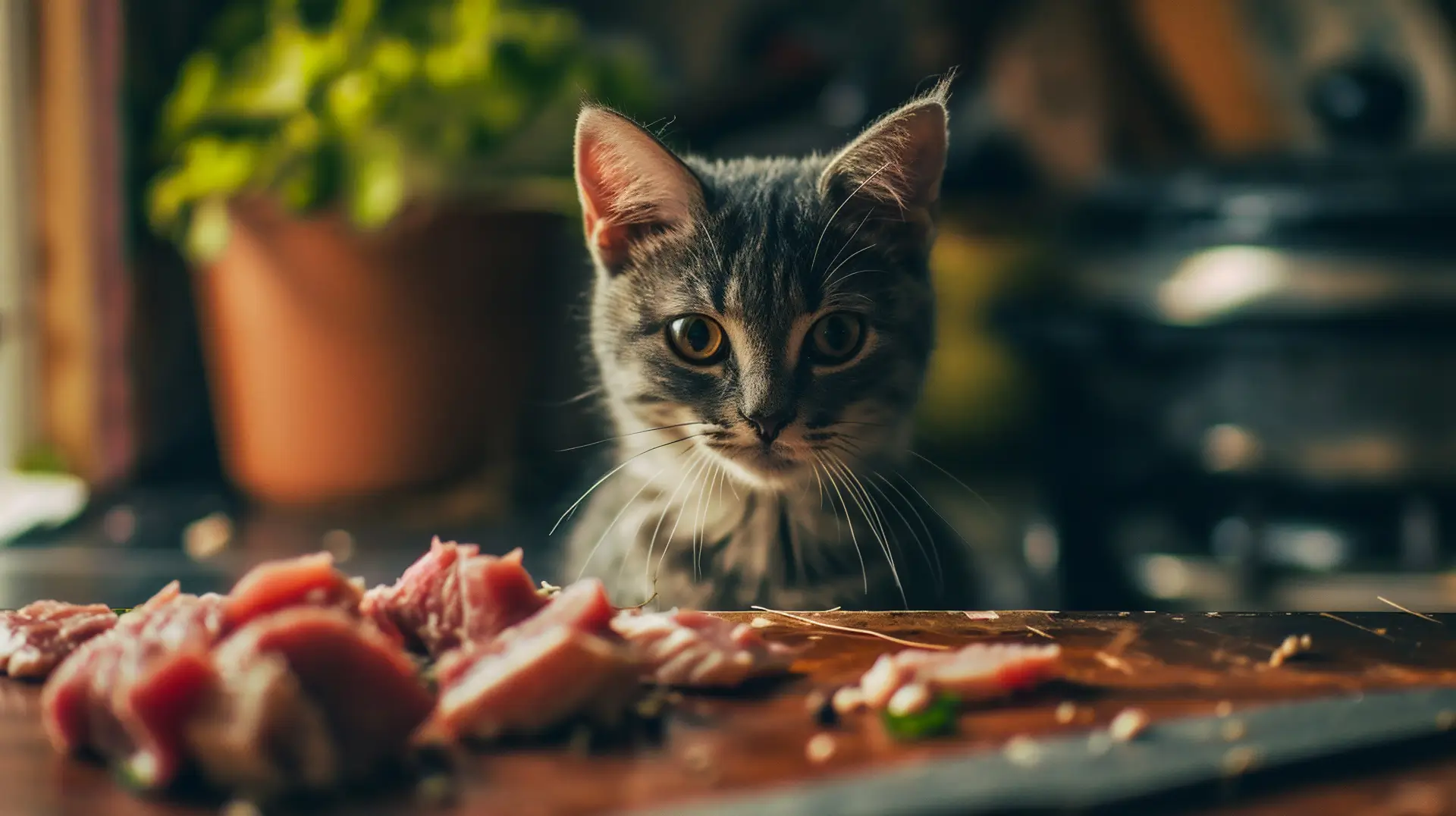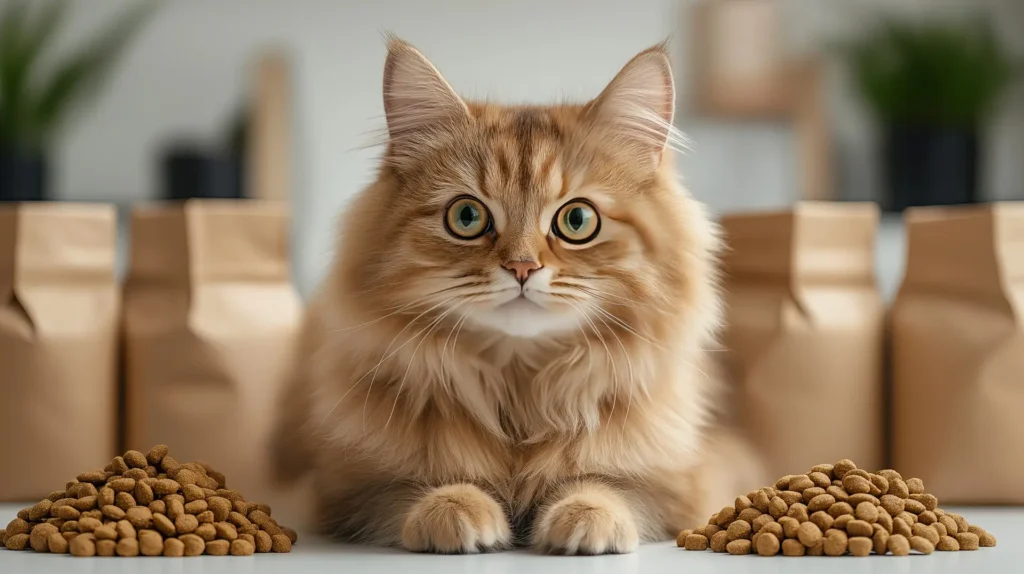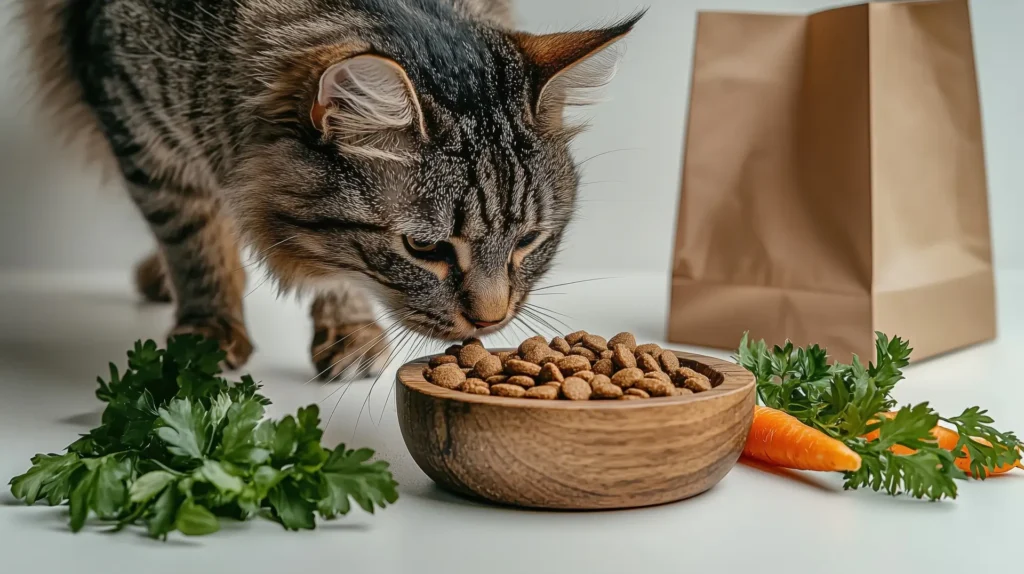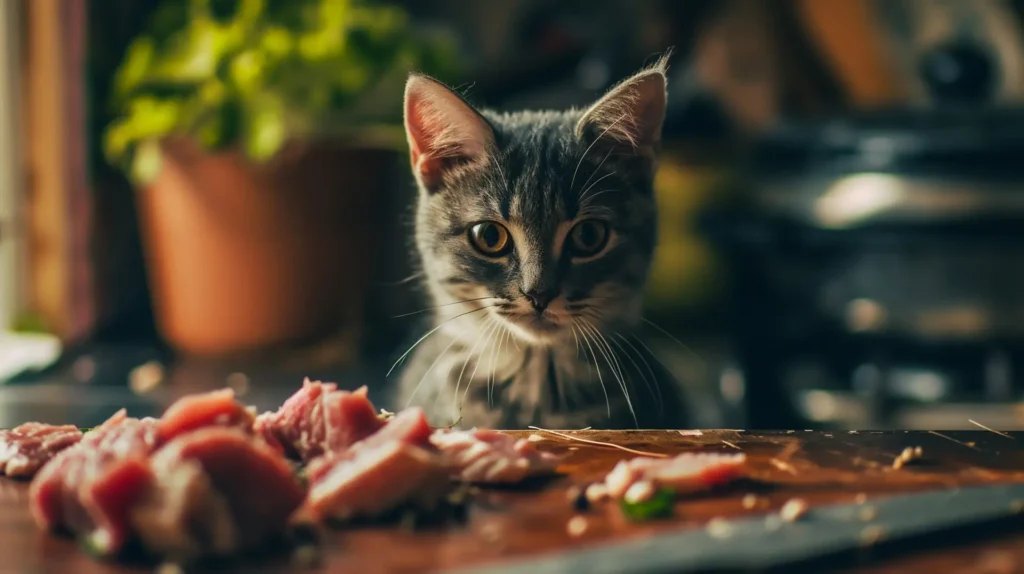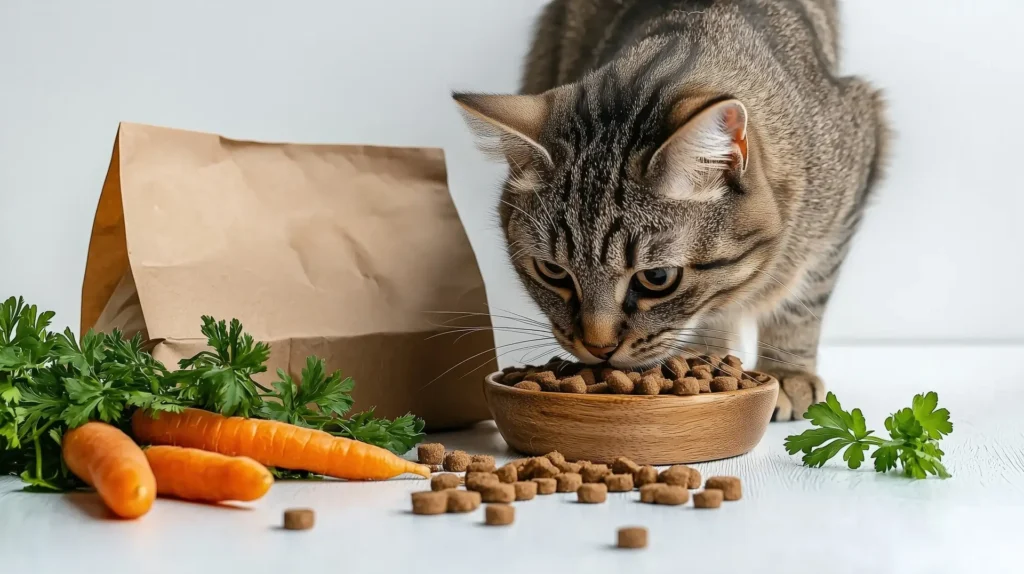The search for the best food for our cats never stops. More cat owners and holistic pet care advocates are choosing to look at nature. Cats are obligate carnivores. This means their bodies need nutrients only found in meat. Advocates say the ideal diet must copy what they eat in the wild. This idea often leads to feeding a raw cat food diet. Forget traditional kibble or canned food for a moment. A species-appropriate diet focuses on fresh ingredients and high-quality animal proteins. These are the true basis of feline cat nutrition.
The concept of feeding raw cat food is simply based on a cat’s biology. Your playful tuxedo cat or majestic Bengal cat has the same digestion as a wild ancestor. Cats thrive on a meat-based diet. This diet is high in protein, moderate in fat, and very low in carbs. This expert guide will explain what raw cat food is. We will cover its potential benefits and its practical challenges. Most importantly, we will teach you how to safely choose this food for your cherished pet.
What is a Raw Cat Diet?
A raw cat diet is a feeding plan at its core. It consists mostly of uncooked meat, organs, and bone. Essential vitamins and minerals are often added. The main goal is to offer a biologically appropriate diet. This food is very easy to digest and full of nutrients. It avoids the heavy processing, fillers, and extra carbs of standard pet foods.
The Composition of Quality Raw Cat Food
The best raw cat food tries to match a whole prey animal’s nutrients. A typical, healthy mix includes:
- Muscle Meat: This is the biggest part of the diet. It is the primary protein source. It gives the cat essential amino acids, including taurine.
- Organ Meats: Organs like liver are full of vitamins and minerals. They are especially rich in Vitamin A.
- Edible Bone: Ground or small pieces of bone provide necessary calcium and phosphorus. These are key for strong bones and nutrient balance.
- Minimal Vegetables/Supplements: Cats do not need carbohydrates. However, a few vegetables may be in commercial formulas. It is crucial that essential fatty acids, vitamins, and minerals are included. This ensures the diet is complete and balanced. A taurine lack can be deadly.
Today, you can find raw cat food in two main forms:
- Homemade Raw Cat Diet: The owner makes all the food. This offers total control over ingredients. Yet, it needs detailed research and a veterinary nutritionist’s guidance. This ensures the diet is complete and safe.
- Commercial Premade Raw Cat Food: This choice is more convenient and safer. The products are sold as frozen or refrigerated cat food brands. They are carefully made to be complete and balanced. Often, they use organic raw cat food ingredients. They are always tested for safety.
The Potential Benefits of Feeding Raw Fresh Cat Food
Owners who choose a raw cat diet often report health improvements. They believe this comes from feeding an unprocessed cat food.
Enhanced Digestibility and Nutrient Absorption
A cat’s short, acidic gut is naturally built to handle a meat-based diet. Raw fresh cat food is never heat-processed. This may preserve natural enzymes and nutrients. This preservation can lead to excellent digestibility. Owners frequently see smaller, less smelly stools. This suggests the cat’s body is absorbing more nutrients.
Improved Skin and Coat Health
A diet high in animal proteins and natural fats is great for pet health. Foods like high-quality natural raw cat food often result in better skin and coat. Owners often notice a much softer, shinier coat. They also see less flaky or dry skin. Essential fatty acids in a balanced formula are vital for skin health.
Better Hydration
Most raw wet cat food has a lot of moisture. The content is similar to what a cat finds in nature (about 65–75%). Cats often don’t drink enough water. This high water content is highly helpful. Good hydration is essential for overall pet health. It supports strong kidney and urinary tract function.
Supporting a Biological Appropriate Lifestyle
The key benefit is giving your cat a diet it was meant to eat. Raw cat food is grain-free and minimally processed. Experts believe it helps maintain a good weight and energy level. It fully meets the cat’s need for high protein and low carbohydrates.
You can discover more ways to care for your pet at Love Your Pets Daily.
Navigating the Safety and Preparation of Raw Cat Food
The possible benefits are very attractive. Still, you must know about and lessen the risks of raw feeding. The main worries are germs and nutritional deficiencies.
The Risk of Pathogens
Raw cat meat can contain bad bacteria. Examples include Salmonella, Listeria, and E. coli. This is true for all raw meat. These germs are a risk to your cat and to people in your house. Cross-contamination is a threat, especially with young children or sick people.
Many trusted commercial refrigerated cat food brands use a safety step called HPP. HPP is High-Pressure Processing. This non-heat method uses very high water pressure. It kills harmful germs while keeping the food’s raw state and nutrients. When choosing commercial raw cat food, always look for brands that use this process.
Ensuring Nutritional Completeness
The biggest danger of a homemade raw cat diet is not enough nutrients. Cats need a precise balance of many things. These include protein, fat, vitamins, and minerals. They also need essential amino acids like taurine. A homemade diet of just muscle meat is likely very imbalanced.
To make sure your cat gets all it needs:
- Choose Complete Commercial Formulas: Look for the best refrigerated cat food or frozen brands that follow AAFCO rules. This applies to all life stages, even for raw kitten food. Experts called veterinary nutritionists create these diets.
- Consult a Professional: If you choose to cook at home, you must get help. Work with a board-certified veterinary nutritionist for a balanced recipe.
Raw Cat Food Hygiene and Handling
You must follow very strict hygiene rules if you feed raw cat food. These practices are absolutely mandatory.
- Storage: Always keep raw pet food separate from your food. Use the lowest shelf in the fridge or freezer. This prevents cross-contamination.
- Preparation: Use cutting boards and tools that are only for raw cat food. Never use your cat’s food bowls to measure the food.
- Cleaning: Wash your hands thoroughly with soap and water after touching the food. Do this before and after feeding your cat. Sanitize all surfaces, bowls, and tools that touched the raw food.
- Feeding: The food must not sit out for over 30 minutes. Throw away any food your cat does not eat right away.
Practical Considerations: Cost and Where to Buy
Starting a raw cat food regimen is a big decision. It affects your cat’s health and your spending plan.
The Cost of a Raw Cat Diet
High-quality, commercial natural raw cat food can be expensive. It is often the priciest food option. The daily cost may be high. This depends on the brand and whether the meat is USDA-inspected. You can find affordable raw cat food options. It is possible to buy cheap, fresh cat food in larger amounts. Yet, never sacrifice complete nutrition and safety for a low price. The cheapest raw cat food that lacks balance will cause costly health issues later.
Where to Buy Raw Cat Food
Commercial premade raw cat food is sold in several places:
- Specialty Pet Food Stores: These shops often stock many frozen and freeze-dried raw brands.
- Online Retailers: Many brands ship directly to your door. The food arrives in insulated packaging to keep it cold.
- Veterinary Offices and Holistic Pet Care Practices: Some vets who support this feeding method sell or recommend reputable brands.
When you buy, make sure the label says the food is complete and balanced for your cat’s age. Choosing a raw cat diet is a personal decision. You must balance the benefits against the work and risks. You can confidently try this holistic pet care approach. Just focus on safety, get expert advice, and pick balanced, quality formulas. Whether you have a beautiful torbie cat or a colorful calico cat, feeding them a biologically appropriate diet shows deep care.
FAQs
What is the best raw food for cats?
The best raw cat food is a complete and balanced commercial formula. It should be open about its sourcing. Look for meat that is USDA inspected. It should use safety methods like HPP to reduce germ risk. It must contain high-quality animal proteins, like taurine. A veterinary nutritionist should have overseen the recipe.
Is wet food better for cats?
Yes, generally raw wet cat food and high-quality canned food are better than dry kibble. This is mainly because of the high moisture content. Cats naturally have a weak thirst drive. The extra water in a raw or wet diet is vital for good hydration. This protects the kidneys and urinary tract.
Is it good for cats to eat raw?
Those who support raw feeding say it is good for cats. It is a biologically appropriate, meat-based diet that offers a great protein source. This may lead to benefits like a shinier coat and better digestion. However, most vets warn against it due to the risk of germs and nutritional problems. They stress that balanced, cooked commercial food is usually safer.
Do vets recommend raw cat food?
Most major veterinary groups do not recommend raw diets. This includes the AVMA and CDC. Their concern is the germ risk to pets and the household. Yet, some vets who focus on holistic pet care may support a well-managed commercial raw diet. You must follow very strict food safety rules if you choose this path.


